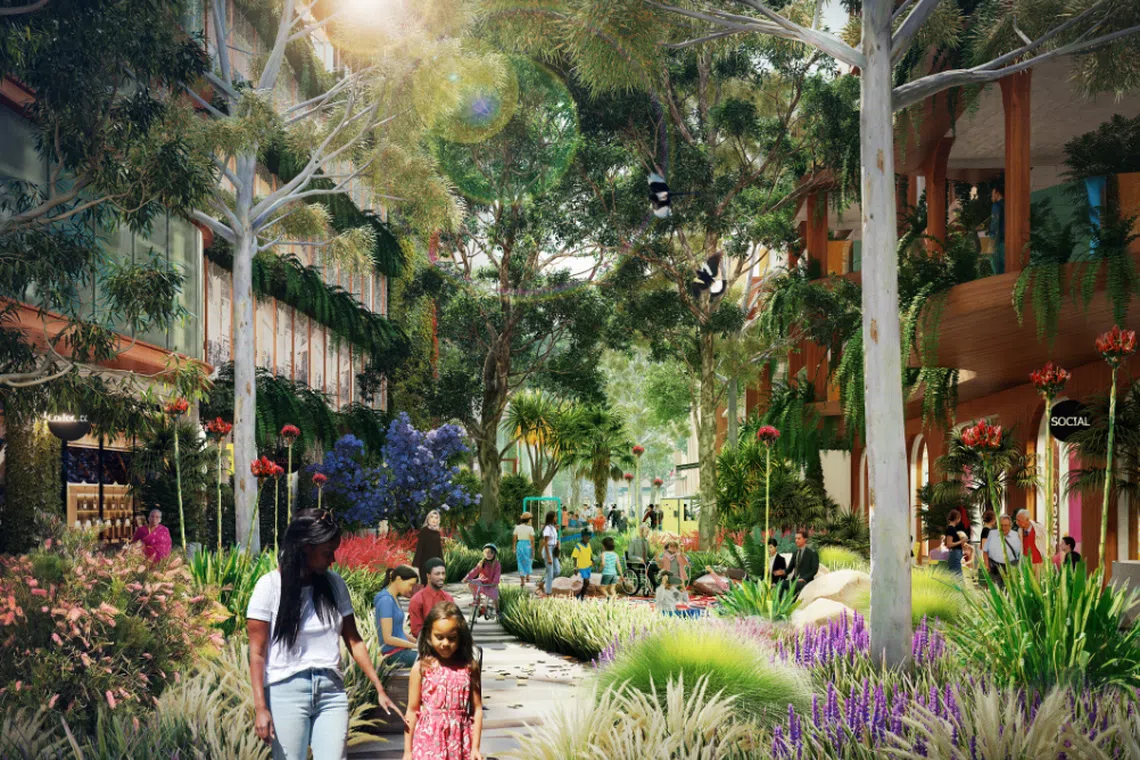Australia’s new city tackles climate change from the ground up
Sign up now: Get ST's newsletters delivered to your inbox

Bradfield City Centre will be home to technology companies, colleges and, further down the line, apartments and houses.
PHOTO: WESTERN PARKLAND CITY AUTHORITY WEBSITE
Follow topic:
SYDNEY – Carbon-neutral buildings and tree-lined streets are at the heart of plans for a brand-new city in a pocket of Australia where temperatures can be among the hottest on earth in the summer and climate change is a major threat.
Bradfield City Centre is under construction on an expanse of dirt and scrub about 56km west of Sydney’s Central Business District and harbour front, neighbouring a new international airport set to open in 2026.
The city and airport are part of the wider Aerotropolis, an area of about 11,000ha – around the size of 15,400 football fields.
The New South Wales state government hopes the development will “supercharge the creation of jobs and economic opportunities” in western Sydney, which is home to about 2.5 million people and has some of the fastest growth rates in Organisation for Economic Cooperation and Development countries.
Backed by A$1 billion (S$889.3 million) from the government and more from a slew of international companies, it will be home to technology companies, colleges and, later, apartments and houses. The first building is set to be completed in 2024.
The new city comes as Australia has faced an increasing number of bush fires,
At Bradfield, the immediate challenge is the area’s extreme summer temperatures, which can soar as much as 10 deg C higher than the city’s east, which is cooled by the ocean.
In January 2020, as wildfires ravaged Australia’s east coast, the temperature reached 48.9 deg C in the Sydney suburb of Penrith, about 22km from Bradfield, making it the hottest place in the world.
There is also concern that deforestation from construction in years gone by has left the area exposed to complications from global warming, such as accelerated soil loss and endangered native animal and plant species.
“The loss of greenery over the years makes this area very vulnerable to climate change,” said Associate Professor Tooran Alizadeh of The University of Sydney who is leading a research team to examine the new urban development. “This is a very sensitive area.”
Some 37 companies are already locked in as state government partners to construct Bradfield.
That list, which includes Northrop Grumman and Mitsubishi Heavy Industries, is expected to expand to 50 by end-2023, according to Western Parkland City Authority chief executive Sarah Hill, who is overseeing the development.
Australia’s top science organisation, CSIRO, will also move some divisions into a purpose-built facility.
Dr Hill, who has spent her career designing city developments, including those for the 2012 London Olympics, said starting with a clean slate meant not having to fix problems further down the line.
“We’ve really brought our partners in early to help us design the city so that it addresses any of those challenges that are emerging globally around climate,” she said. “This is really flipping the model on its head.”
Sustainability targets are being monitored at Bradfield from planning to construction.
By ensuring 100 per cent renewable energy use – from solar, wind, hydrogen and bioenergy – while integrating water treatment from the start to reduce waste, planners are banking on green outcomes well before the city is populated.
To deal with the heat, commercial and residential planning applications need to show if roofs and paved surfaces are designed to reduce adverse effects of solar heat on the surrounding land. This includes a requirement for light-coloured roofs.
“Rather than starting with housing, we’re starting with what industry and businesses need, and this is quite a different approach to planning cities in my experience and decades of doing this,” Dr Hill said.
With increased focus on environmental, social and governance factors in recent years, however, there are heated discussions of the “massive environmental and societal issues in that location”, Prof Alizadeh said.

The New South Wales state government hopes the development will “supercharge the creation of jobs and economic opportunities” in western Sydney.
PHOTO: WESTERN PARKLAND CITY AUTHORITY WEBSITE
In addition to the environmental impact, the project will be scrutinised for how it consults with Indigenous peoples.
When the city’s name was revealed in 2021, controversy ensued when it was confirmed that an Indigenous word would not be used. Instead, the name would honour engineer John Bradfield, most noted for his design and construction of the Sydney Harbour Bridge.
The controversy comes as the country later in 2023 is expected to hold a referendum that would give Indigenous Australians an official voice in Parliament. Some western Sydney suburbs near the airport development have proportionately more than the 3.2 per cent national average of First Nations people.
The parkland development body acknowledges that projects of this size are not supposed to be straightforward.
“This is one of the most unique opportunities that we have in the world to create a city from scratch, from a clean slate, but also on the doorstep of an existing global city,” said Dr Hill. BLOOMBERG

